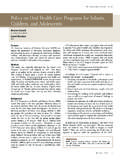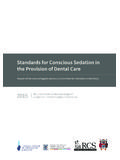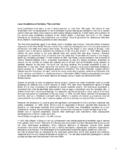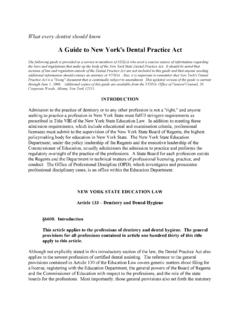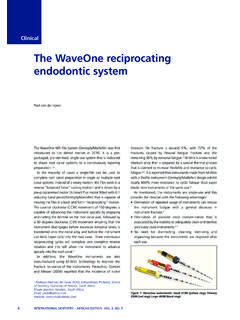Transcription of Management of the Developing ... - Pediatric Dentistry
1 352 RECOMMENDATIONS: BEST PRACTICESREFERENCE MANUAL V 40 / NO 6 18 / 19 PurposeThe American Academy of Pediatric Dentistry (AAPD) recognizes the importance of managing the Developing den- tition and occlusion and its effect on the well-being of infants, children, and adolescents. Management includes the recognition, diagnosis, and appropriate treatment of dento- facial abnormalities. These recommendations are intended to set forth objectives for Management of the Developing dentition and occlusion in Pediatric on Management of the Developing dentition and occlusion were developed by the Clinical Affairs Com- mittee Developing Dentition Subcommittee and adopted in 1990.
2 This document is a revision of the previous version, last revised in 2009. This revision is based upon a new PubMed /MEDLINE search using the terms: tooth ankylosis, Class II malocclusion, Class III malocclusion, interceptive or- thodontic treatment, evidence-based, dental crowding, ectopic eruption, dental impaction, obstructive sleep apnea syndrome (OSAS), occlusal development, craniofacial development, cran- iofacial growth, airway, facial growth, oligodontia, oral habits, occlusal wear and dental erosion, anterior crossbite, posterior crossbite, space maintenance, third molar development, and tooth size/arch length discrepancy; fields: all.
3 Limits: within the last 10 years, humans, English, and birth through age 18. Papers for review were chosen from these searches and from references within selected articles. When data did not appear sufficient or were inconclusive, recommendations were based upon expert and/or consensus opinion by experienced researchers and Guidance of eruption and development of the primary, mixed, and permanent dentitions is an integral component of com- prehensive oral health care for all Pediatric dental patients. Such guidance should contribute to the development of a permanent dentition that is in a stable, functional, and esthe-tically acceptable occlusion and normal subsequent dentofacial development.
4 Early diagnosis and successful treatment of Developing malocclusions can have both short-term and long-term benefits while achieving the goals of occlusal harmony and function and dentofacial Dentists have the responsibility to recognize, diagnose, and manage or refer abnormalities in the Developing dentition as dictated by the complexity of the problem and the individual clinician s training, knowledge, and Many factors can affect the Management of the Developing dental arches and minimize the overall success of any treat- ment.
5 The variables associated with the treatment of the Developing dentition that will affect the degree to which treatment is successful include, but are not limited to: 1. chronological/mental/emotional age of the patient and the patient s ability to understand and cooperate in the treatment. 2. intensity, frequency, and duration of an oral habit. 3. parental support for the treatment. 4. compliance with clinician s instructions. 5. craniofacial configuration. 6. craniofacial growth. 7. concomitant systemic disease or condition.
6 8. accuracy of diagnosis. 9. appropriateness of timing of treatment. A thorough clinical examination, appropriate pretreatment records, differential diagnosis, sequential treatment plan, and progress records are necessary to manage any condition affect- ing the Developing dentition. Clinical examination should include: 1. Facial analysis to: a. identify adverse transverse growth patterns inclu- ding asymmetries (maxillary and mandibular); b. identify adverse vertical growth patterns; c. identify adverse sagittal (anteroposterior) growth patterns and dental anteroposterior (AP) occlusal disharmonies; andd.
7 Assess esthetics and identify orthopedic and ortho- dontic interventions that may improve esthetics and resultant self-image and emotional development. Review CouncilCouncil on Clinical AffairsLatest Revision2014 Management of the Developing Dentition and Occlusion in Pediatric DentistryABBREVIATIONS AAPD: American Academy Pediatric Dentistry . AP: Anteroposterior. CBCT: Cone-beam computed tomography. EE: Ectopic eruption. OSAS: Obstructive sleep apnea syndrome. AMERICAN ACADEMY OF Pediatric DENTISTRYRECOMMENDATIONS: BEST PRACTICES 3532. Intraoral examination to: a. assess overall oral health status; and b.
8 Determine the functional status of the patient s occlusion. 3. Functional analysis to: a. determine functional factors associated with the malocclusion; b. detect deleterious habits; and c. detect temporomandibular joint dysfunction, which may require additional diagnostic pro- cedures. Diagnostic records may be needed to assist in the evalua- tion of the patient s condition and for documentation pur- poses. Prudent judgment is exercised to decide the appropriate records required for diagnosis of the clinical Diagnostic orthodontic records fall into three major catego- ries of evaluation: (1) health of the teeth and oral structures, (2) alignment and occlusal relationships of the teeth, and (3) facial and jaw proportions which includes both cephalometric radiographs and facial photographs.
9 Digital images, including cone-beam computed tomographic images (CBCT), are supplementing and/or replacing film as records, especially in cases of impacted Diagnostic records may include: 1. Extraoral and intraoral photographs to: a. supplement clinical findings with oriented facial and intraoral photographs; and b. establish a database for documenting facial changes during treatment. 2. Diagnostic dental casts to: a. assess the occlusal relationship; b. determine arch length requirements for intraarch tooth size relationships; c.
10 Determine arch length requirements for interarch tooth size relationships; andd. determine location and extent of arch asymmetry. 3. Intraoral and panoramic radiographs to: a. establish dental age; b. assess eruption problems; c. estimate the size and presence of unerupted teeth; andd. identify dental anomalies/pathology. 4. Lateral and AP cephalograms to: a. produce a comprehensive cephalometric analysis of the relative dental and skeletal components in the anteroposterior, vertical, and transverse di- mensions; b. establish a baseline growth record for longitudinal assessment of growth and displacement of the jaws; and c.

